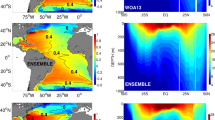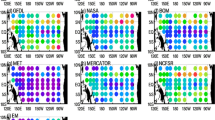Abstract
The TAO/TRITON array is the cornerstone of the tropical Pacific and ENSO observing system. Motivated by the recent rapid decline of the TAO/TRITON array, the potential utility of TAO/TRITON was assessed for ENSO monitoring and prediction. The analysis focused on the period when observations from Argo floats were also available. We coordinated observing system experiments (OSEs) using the global ocean data assimilation system (GODAS) from the National Centers for Environmental Prediction and the ensemble coupled data assimilation (ECDA) from the Geophysical Fluid Dynamics Laboratory for the period 2004–2011. Four OSE simulations were conducted with inclusion of different subsets of in situ profiles: all profiles (XBT, moorings, Argo), all except the moorings, all except the Argo and no profiles. For evaluation of the OSE simulations, we examined the mean bias, standard deviation difference, root-mean-square difference (RMSD) and anomaly correlation against observations and objective analyses. Without assimilation of in situ observations, both GODAS and ECDA had large mean biases and RMSD in all variables. Assimilation of all in situ data significantly reduced mean biases and RMSD in all variables except zonal current at the equator. For GODAS, the mooring data is critical in constraining temperature in the eastern and northwestern tropical Pacific, while for ECDA both the mooring and Argo data is needed in constraining temperature in the western tropical Pacific. The Argo data is critical in constraining temperature in off-equatorial regions for both GODAS and ECDA. For constraining salinity, sea surface height and surface current analysis, the influence of Argo data was more pronounced. In addition, the salinity data from the TRITON buoys played an important role in constraining salinity in the western Pacific. GODAS was more sensitive to withholding Argo data in off-equatorial regions than ECDA because it relied on local observations to correct model biases and there were few XBT profiles in those regions. The results suggest that multiple ocean data assimilation systems should be used to assess sensitivity of ocean analyses to changes in the distribution of ocean observations to get more robust results that can guide the design of future tropical Pacific observing systems.
















Similar content being viewed by others
References
Alves O, Balmaseda M, Anderson D, Stockdale T (2004) Sensitivity of dynamical seasonal forecasts to ocean initial conditions. Q J R Meteorol Soc 130:647–668
Anderson JL (2003) A local least squares framework for ensemble filtering. Mon Weather Rev 131:634–642
Ando K, Matsumoto T, Nagahama T, Ueki I, Takatsuki Y, Kuroda Y (2005) Drift characteristics of a moored conductive-temperature-depth sensor and correction salinity data. J Atmos Ocean Technol 22:282–291. doi:10.1175/JTECH1704.1
Balmaseda MA, Anderson D (2009) Impact of initialization strategies and observations on seasonal forecast skill. Geophys Res Lett 36:L01701. doi:10.1029/2008GL035561
Balmaseda MA, Anderson D, Vidard A (2007) Impact of Argo on analyses of the global ocean. Geophys Res Lett 34:L16605. doi:10.1029/2007GL030452
Balmaseda MA, Mogensen K, Weaver AT (2013) Evaluation of the ECMWF ocean reanalysis system ORAS4. Q J R Meteorol Soc 131:1132–1161
Behringer DW, Xue Y (2004) Evaluation of the global ocean data assimilation system at NCEP. In: The Pacific Ocean. Eighth symposium on integrated observing and assimilation system for atmosphere, ocean, and land surface, AMS 84th annual meeting, Washington State Convention and Trade Center, Seattle, pp 11–15, 10 Jan 2004
Behringer DW (2007) The global ocean data assimilation system at NCEP. In: 11th symposium on integrated observing and assimilation systems for atmosphere, oceans, and land surface, AMS 87th annual meeting
Behringer DW, Ji M, Leetmaa A (1998) An improved coupled model for ENSO prediction and implications for ocean initialization. Part I: the ocean data assimilation system. Mon Weather Rev 126:1013–1021
Bonjean F, Lagerloef GSE (2002) Diagnostic model and analysis of the surface currents in the tropical pacific ocean. J Phys Oceanogr 32:2938–2954
Bourlès B, Lumpkin R, McPhaden MJ, Hernandez F, Nobre P, Campos E, Yu L, Planton S, Busalacchi AJ, Moura AD, Servain J, Trotte J (2008) The PIRATA program: history, accomplishments, and future directions. Bull Am Meteorol Soc 89:1111–1125
Boyer TP et al (2009) World ocean database 2009, chapter 1: introduction. In: Levitus S (ed) NOAA Atlas NESDIS 66. US Government Printing Office, Washington, DC, 216 pp
Chang YS, Zhang S, Rosati A, Delworth TL, Stern WF (2013) An assessment of oceanic variability for 1960–2010 from the GFDL ensemble coupled data assimilation. Clim Dyn 40:775–803. doi:10.1007/s00382-012-1412-2
Conkright ME et al (1999) World ocean database 1998, documentation and quality control version 2.0. National Oceanographic Data Center internal report 14. National Oceanographic Data Center, Silver Spring
Delworth TL et al (2006) GFDL’s CM2 global coupled climate model. Part I: formulation and simulation characteristics. J Clim 19:643–674
Derber J, Rosati A (1989) A global oceanic data assimilation system. J Phys Oceanogr 19:1333–1347
Fujii Y, Kamachi M, Nakaegawa T, Yasuda T, Yamanaka G, Toyoda T, Ando K, Matsumoto S (2011) Assimilating ocean observation data for ENSO monitoring and forecasting. In: Hannachi A (ed) Climate variability. INTECH, Rijeka. ISBN: 979-953-307-236-3
Fujii Y, Cummings J, Xue Y, Schiller A, Lee T, Balmaseda MA, Remy E, Masuda S, Brassington G, Alves O, Cornuelle B, Martin M, Oke P, Smith G, Yang X (2015) Evaluation of the tropical Pacific observing system from the ocean data assimilation perspective. Q J R Meteorol Soc. doi:10.1002/qj.2579
Good SA, Martin MJ, Rayner NA (2013) EN4: quality controlled ocean temperature and salinity profiles and monthly objective analyses with uncertainty estimates. J Geophys Res (Oceans) 118:6704–6716. doi:10.1002/2013JC009067
Hackert E, Ballabrera-Poy J, Busalacchi AJ, Zhang RH, Murtugudde RG (2011) Impact of sea surface salinity assimilation on coupled forecasts in the tropical Pacific. J Geophys Res 116:C05009
Hu ZZ, Kumar A (2015) Influence of availability of TAO data on NCEP ocean data assimilation systems along the equatorial Pacific. J Geophys Res Ocean. doi:10.1002/2015JC010913
Ji M, Kumar A, Leetmaa A (1994) An experimental coupled forecast system at the national meteorological center: some early results. Tellus 46A:398–418
Ji M, Behringer DW, Leetmaa A (1998) An improved coupled model for ENSO prediction and implications for ocean initialization. Part II: the coupled model. Mon Weather Rev 126:1022–1034
Kalnay E et al (1996) The NCEP/NCAR 40-year reanalysis project. Bull Am Meteorol Soc 77:437–471
Kanamitsu M, Ebitsuzaki W, Woolen J, Yang SK, Hnilo JJ, Fiorino M, Potter GL (2002) NCEP-DOE AMIP-II reanalysis (R-2). Bull Am Meteorol Soc 83:1631–1643
Kumar A, Wang H, Xue Y, Wang W (2014) How much of monthly subsurface temperature variability in equatorial pacific can be recovered by the specification of sea surface temperatures? J Clim 27:1557–1559
Large WG, McWilliams JC, Doney SC (1994) Oceanic vertical mixing: a review and a model with a nonlocal boundary layer parameterization. Rev Geophys 32(4):363–404
Latif M, Anderson D, Barnett T, Cane M, Kleeman R, Leetmaa A, O’Brien J, Rosati A, Schneider E (1998) A review of the predictability and prediction of ENSO. J Geophys Res 103:14375–14393
Maes C, McPhaden M, Behringer DW (2002) Signatures of salinity variability in tropical Pacific Ocean dynamic height anomalies. J Geophys Res 107:8012–8024. doi:10.1029/2000JC000737
Maes C, Picaut J, Belamari S (2005) Importance of salinity barrier layer for the buildup of El Nino. J Clim 18:104–118
McPhaden MJ et al (1998) The tropical ocean-global atmosphere (TOGA) observing system: a decade of progress. J Geophys Res 103:14169–14240
McPhaden MJ et al (2009) RAMA: the research moored array for African–Asian–Australian monsoon analysis and prediction. Bull Am Meteorol Soc 90:459–480
Murtugudde R, Busalacchi AJ (1998) Salinity effects in a tropical ocean model. J Geophys Res 103:3283–3300
Neelin D, Battisti DS, Hirst AC, Jin FF, Wakata Y, Yamagata T, Zebiak SE (1998) ENSO theory. J Geophys Res 103:14261–14290
Rayner NA et al (2003) Global analyses of sea surface temperature, sea ice, and night marine air temperature since the late nineteenth century. J Geophys Res 108(D14):4407. doi:10.1029/2002JD002670
Reynolds RW, Rayner NA, Smith TM, Stokes DC, Wang W (2002) An improved in situ and satellite SST analysis for climate. J Clim 15:1609–1625
Reynolds RW, Smith TM, Liu C, Chelton DB, Casey KS, Schlax MG (2007) Daily high-resolution blended analyses for sea surface temperature. J Clim 20:5473–5496
Rosati A, Miyakoda K, Gudgel R (1997) The impact of ocean initial conditions on ENSO forecasting with a coupled model. Mon Weather Rev 125:754–772
Saha S et al (2010) The NCEP climate forecast system reanalysis. Bull Am Meteorol Soc 91:1015–1057
Smith SR, Hughes PJ, Bourassa MA (2011) A comparison of nine monthly air–sea flux products. Int J Climatol 31:1002–1027
Stockdale TN, Anderson DLT, Alves JOS, Balmaseda MA (1998) Global seasonal rainfall forecasts using a coupled ocean–atmosphere model. Nature 392:370–373
Stockdale TN, Anderson D, Balmaseda MA, Doblas-Reyes F, Ferranti L, Mogensen K, Palmer TN, Molteni F, Vitart F (2011) ECMWF seasonal forecast system 3 and its prediction of sea surface temperature. Clim Dyn. doi:10.1007/s00382-010-0947-3
Sun C, Rienecker MM, Rosati A, Harrison M, Wittenberg A, Keppenne CL, Jacob JP, Kovach RM (2007) Comparison and sensitivity of ODASI ocean analysis in the tropical Pacific. Mon Weather Rev 135:2242–2264
Tollefson J (2014) El Niño tests forecasters. Nature 508:20–21. doi:10.1038/nature.2014.14582
Vecchi G et al (2014) On the seasonal forecasting to regional tropical cyclone activity. J Clim 27:7994–8016
Vidard A, Anderson DLT, Balmaseda M (2007) Impact of ocean observing systems on ocean analysis and seasonal forecasts. Mon Weather Rev 135:409–429
Wittenberg AT, Rosati A, Lau NC, Ploshay JJ (2006) GFDL’s CM2 global coupled climate models. Part III: tropical Pacific climate and ENSO. J Clim 19:698–722
Xue Y, Huang B, Hu ZZ, Kumar A, Wen C, Behringer DW, Nadiga S (2011) An assessment of oceanic variability in the NCEP climate forecast system reanalysis. Clim Dyn 37:2511–2539. doi:10.1007/s00382-010-0954-4
Xue Y, Balmaseda MA, Boyer T, Ferry TN, Good S, Ishikawa I, Kumar A, Rienecker M, Rosati T, Yin Y (2012) A comparative analysis of upper ocean heat content variability from an ensemble of operational ocean reanalyses. J Clim 25:6905–6929
Xue Y, Chen M, Kumar A, Hu ZZ, Wang W (2013) Prediction skill and bias of tropical Pacific sea surface temperatures in the NCEP climate forecast system version 2. J Clim 26:5358–5378
Yang X et al (2013) A predictable AMO-like pattern in GFDL’s coupled initialization and decadal forecasting system. J Clim 26:650–661
Yin Y, Alves O, Oke PR (2011) An ensemble ocean data assimilation system for seasonal prediction. Mon Weather Rev 139:786–808
Zhang S, Harrison MJ, Rosati A, Wittenberg A (2007) System design and evaluation of coupled ensemble data assimilation for global oceanic studies. Mon Weather Rev 135:3541–3564
Zhao M, Hendon H, Alves O, Yin Y (2014) Impact of improved assimilation of temperature and salinity for coupled model seasonal forecasts. Clim Dyn 42:2565–2583
Zhu J, Huang ZhangRH, Hu ZZ, Kumar A, Balmaseda MA, Kinter JL (2014) Salinity anomaly as a trigger for ENSO events. Sci Rep 4:6821. doi:10.1038/srep06821
Acknowledgments
We would like to thank support from the NOAA Climate Observation Division of Climate Program Office for this study. We also thank two anonymous reviewers, Dr. Zeng-Zhen Hu and Dr. Jieshun Zhu for their constructive comments and suggestions on this paper. The scientific results and conclusions, as well as any view or opinions expressed herein, are those of the author(s) and do not necessarily reflect the views of NWS, NOAA, or the Department of Commerce.
Author information
Authors and Affiliations
Corresponding author
Additional information
This paper is a contribution to the special issue on Ocean estimation from an ensemble of global ocean reanalyses, consisting of papers from the Ocean Reanalyses Intercomparsion Project (ORAIP), coordinated by CLIVAR-GSOP and GODAE OceanView. The special issue also contains specific studies using single reanalysis systems.
Rights and permissions
About this article
Cite this article
Xue, Y., Wen, C., Yang, X. et al. Evaluation of tropical Pacific observing systems using NCEP and GFDL ocean data assimilation systems. Clim Dyn 49, 843–868 (2017). https://doi.org/10.1007/s00382-015-2743-6
Received:
Accepted:
Published:
Issue Date:
DOI: https://doi.org/10.1007/s00382-015-2743-6




